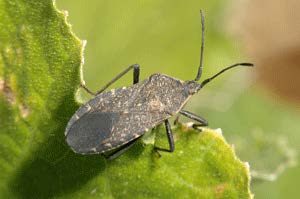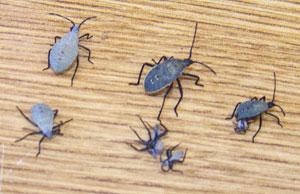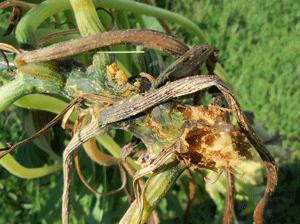Squash bugs and squash vine borer are typically a problem throughout the growing season, most often the problem is seen in June and July.
Squash bugs and squash vine borers are both voracious pests of the cucurbit, or cucumber, family. This family of plants includes squash, zucchini, cucumbers, pumpkins, gourds, and all types of melons. If you grow more than one type of these plants in your garden and you find either of these insects on one, you will need to treat all the plants because it is very likely that you will find them on all the related plants.
Squash Bugs
Squash bugs are a type of true bug, a close relative of lace bugs, boxelder bugs, aphids, and cicadas. These insect pests can completely destroy your garden in a matter of days. Squash bugs look like stink bugs when fully grown, but as they develop; they look like tiny, gray, elongated bugs with black legs. You will typically find a group of them at different stages of development in large groups on your plants. Before you find the bugs you may see a small grouping of bright red eggs on the undersides of your plant leaves. Squash bugs cause damage by sucking the sap from plant stems and leaves. Leaves start to look yellowish or even stippled, or spotted, yellow and then eventually the whole leaf or group of leaves will turn brown. They also may feed on your vegetables causing damage to the fruit such as holes or spots.
Squash Vine Borer
Squash vine borer is an immature form of a moth. These insects are not seen before their damage occurs. The adult moths will lay their eggs on the base of the stem of a zucchini, cucumber, melon, etc and when the eggs hatch the larvae will burrow into the stem of the plant. The damage is a suddenly wilted vine or plant that looks like it is in need of a good watering. If you pull the plant out of the ground, it will break off at soil level and it will have holes with sawdust in them. If you slice open the stem, you will find a white caterpillar burrowing through the stem or vine. Squash vine borer activity through the stem reduces or completely cuts off the flow of water and nutrients throughout the plant.
If you get squash vine borer in your cucurbits, there is no way to save that particular plant that the borer is in. The only thing to do at this point is to try to save the plants that have not yet been attacked by the squash vine borer. You should treat the base of your plants with a chemical containing carbaryl, bifenthrin, or permethrin every 7-10 days throughout the growing season.
Control
The control for both squash bug and squash vine borer is the same, however you need to make sure that you are spraying or dusting the entire plant, paying special attention to the main stem right at the soil level to ensure good control for the borer. Both are treated with the same chemical and it should be done every 7-10 days, it would be a good idea to switch between the three chemicals listed each time that you make an application to reduce the incidence of resistance. Another thing to remember is that once you get either squash bug or squash vine borer, you will probably always have a problem with them in the future at that location. A good tip is that if you had one or both of these pests in past years, you should just start applying the chemical controls in the spring as the plants are becoming established in June as a proactive measure to control these pests.
If you want to avoid using pesticides for these two insect pests, there are other alternatives. Obviously, one good way to control these pests is to reduce the population that overwinters in your garden. Be sure to use good fall management practices to ensure they don’t have a nice overwintering location in your garden, by removing all plant debris every fall and tilling up the soil to expose the pupae to cold air and predators during the winter. You can also utilize row covers to physically separate the squash vine borer from the stem of your plants to keep them from laying eggs on the cucurbits you have planted. If you choose to use row covers you may want to use plants that are gynecious, meaning that they do not require pollination for the fruits to be produced.
Squash vine borers typically prefer winter squash and are less harmful to zucchini and summer squash, so choose not to plant winter squash varieties to try to avoid the problems. Another way to block the squash vine borer females from laying eggs on your cucurbits is to put old nylon stockings or a used toilet paper or paper towel tube around the vines at the soil level. The females will not lay eggs through the nylon because it doesn’t feel right and they cannot penetrate the cardboard tube of the toilet paper roll to lay their eggs on the plants. Finally, if all else fails and you don’t want to use chemicals, you can always pick the insects off of the plant and pick off any leaves that have eggs on them and throw them into a bucket of soapy water to get rid of the insects. However, the method of hand picking each insect off the plant is going to take a lot of work and scouting will need to be done daily.



